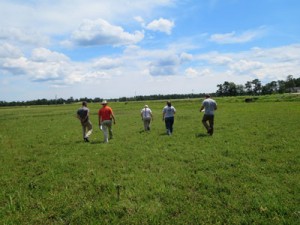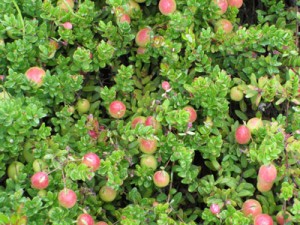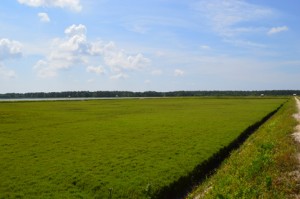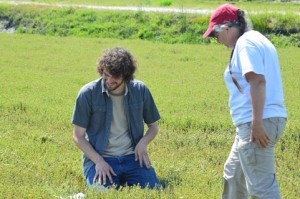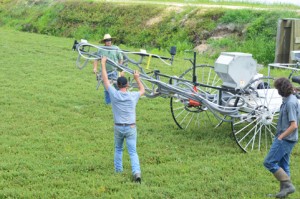Our team just finished another productive follow-up visit with soil scientist Dr. Joan Davenport! Joan comes to see us in the spring during the bloom period and again in the height of summer to discuss fertilizer needs for bud set. Joan looks at hook, the length and color of the new upright growth, and the amount and color of old leaves, including looking for leaves from two growing seasons ago.
Additional plant nutrition is necessary because while cranberries have adapted (and thrive) in their native sandy soil, nutrients are taken from the bog through the harvest of fruit. The three main elements usually added for nutrition are nitrogen, phosphorus, and potassium. This time of year we look for recommendations for bud set fertilizer as we have to make sure the plants have enough to maintain the fruit as it finishes sizing up before harvest, but also that the plants set buds for next year’s crop. With a perennial crop, we’re always thinking about this year and the next; all the years are related.
“At this point in the growing season, we are evaluating the plants to complete the grown season and support next year’s crop,” Joan says. “To do this, I look at the crop load, the presence and quantity of buds, the length and color of the new upright growth, and the color of last growing season’s leaves. This season’s new leaves should be green and the old (last year’s) leaves just starting to turn pale. Larger crop loads indicate higher nitrogen demand. There should be visible buds and few to no uprights actively growing, plus few to no runners present.”
“We looked at a lot of bogs this week and I think she pretty much agreed with everything we did,” says Mike Haines. “It looks like we made the right calls. There are some beds that are a little growthier than we like, some stuff a little hungrier, but that’s about normal. We talked a little bit about sanding, and talked about next spring based on what it looked like now, with some early recommendations for the roughneck stage. Nothing too notable or different for the established beds, really.”
“Mike Scullion and I also took her out to Icehouse, which are two new beds we planted a couple years ago,” he says. “They’re growing great but some of them are a weird yellow color, so we wondered what was up. Turns out they’re mostly just young and still establishing fruit, but Joan thought maybe there was a micronutrient deficiency and recommended fish fertilizer for next year. We did that at the Birches a couple times last year and it’s full of micronutrients she thought would be good for this particular situation.”
It’s always good when Joan’s recommendations remain fairly consistent; it means our team did a good job keeping everything steady and giving the beds what they needed through the season, so that all they need to do is put the finishing touches on to take us through the rest of the summer and into harvest!

